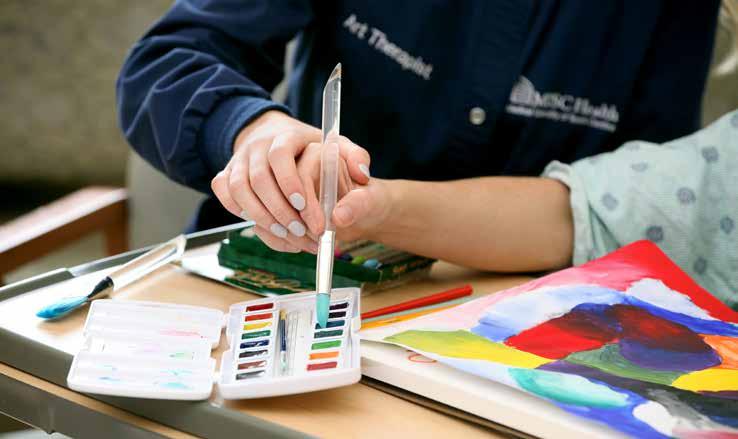




Springtime is approaching, which means it’s time to get to Spring Cleaning! Our Farm Bureau Insurance agents can help you refresh your auto, home, and life insurance policies to fit your needs. Call your local agent today to schedule your annual review or to get a no-obligation quote. Or, use the QR code to get started today!




























The weather is warming up and our daylight hours have lengthened considerably. March has always been one of my favorite months because the temperature is comfortable without being sweltering. The grass begins turning green and now requires more consistent attention than it did over the winter. Spring is here!
My youngest child, Noah, turns eighteen in May and is planning to attend the Citadel in the fall. I can’t believe how time has flown by and now our “baby boy” is about to leave the nest soon. I’m very proud of him and how hard he has grown academically, athletically and most importantly, spiritually.
Life is a journey, filled with different seasons which include both peaks and valleys. I’m excited to watch him and our other kids as they navigate through the game of life and all its unpredictable awesomeness.
What are your plans for Spring? How about a trip to a local garden center to spruce up and refresh your yard’s landscape after a cold winter? Maybe a spring break trip to visit either a warmer or colder climate for some rest and relaxation on the beach or the slopes? How about a staycation with day trips to some lesser known but incredible local attractions?
No matter what you and your family’s plans are for March, I wish only the best experience for you all. Enjoy your time together piloting your ship through the ocean of life.
Thanks for reading Irmo-Chapin Life Magazine. It has been an honor to bring you Irmo-Chapin Life for over fifteen years. I do not take it for granted and I am grateful to our readers and sponsors that help make it all possible.
Warmest regards,

Todd Shevchik Publisher & Editor-In-Chief toddshevchik@gmail.com
Jan Johnson Editor & Director of Digital Media lexlifeeditor@gmail.com Anne Reynolds Sales Director annerabonreynolds5@gmail.com
Stanfield
jess.lex.irmo.chapin.life@gmail.com

kimcurlee214@gmail.com
jcarterdesign@comcast.net
Saturday, March 8
Indoor Yard Sale
Crooked Creek Park | 1098 Old Lexington Hwy. Chapin | 7 am – 11 am
Clean out your garage, attic, kid’s rooms, and closets, and participate as a vendor or drop by for some great bargains and treasures. Visit icrc.net for more information.
Friday, March 14 and
Saturday, March 15
Spring Fling
Wingard’s Market | 1403 N. Lake Dr. Lexington
Stock up on all your spring gardening essentials during this annual weekend of specials, giveaways, and supplier showcases. Visit wingardsmarket.com for more information.
Friday, March 14 - Sunday, March 16
Carolina Classic Home & Garden Show
SC State Fairgrounds | 1200 Rosewood Dr. Columbia
Turn your dream home into a reality with the finest construction, remodeling, and gardening experts from across the Midlands. For more information visit homeshowcolumbia.com
Saturday, March 22
Irmo Cherry Blossom Festival
Irmo Town Park | 7330 Carlisle St. | Irmo 10 am – 5 pm
This family-friendly festival features quiet picnicking, blossom-viewing, plein air art, handcrafted artwork, and more. For more information visit townofirmosc.com.
Thursday, March 27
Taste of Lake Murray
Doubletree by Hilton | 2100 Bush River Rd. Columbia | 6 pm
Join the “Party With A Purpose” fundraiser and support the Fourth of July Celebration at Lake Murray. For tickets visit lakemurraycountry.com.
Saturday, March 29
Pimento Cheese Festival
Saluda Shoals Park | 6071 St. Andrews Rd. Columbia | 11 am – 4 pm
A family-friendly event that will feature live music, an art and craft fair, outdoor games, inflatables, and more. Visit scpimentocheesefest.com for more information.
Saturday, April 5
Egg Hunt
Saluda Shoals Park | 6071 St Andrews Rd. Columbia | 4 pm – 6 pm
Bring your basket for a fun-filled and festive egg hunt at Saluda Shoals Park. Food trucks and vendors will be available. For tickets visit icrc.net.
Thursday, April 3 – Sunday, April 6
12th Annual Tartan Day South Highland Games and Celtic Festival
2001 Charleston Hwy. | Cayce
Tartan Day South honors the Celtic culture and heritage in South Carolina’s Midlands region. Proceeds benefit the River Alliance. For event schedule visit tartandaysouth.com.
Thursday, April 10 – Sunday, April 13
Midlands Spring Plant and Flower Festival
SC State Farmers Market
3483 Charleston Hwy. | West Columbia
Shop spring plants and flowers, gardening equipment, décor, and seasonal produce at the State Farmers Market. Admission and parking are free.
Saturday, April 26
The Tams
Harbison Theatre | 7300 College St. | Irmo 7:30 pm
Experience the timeless magic of the Tams, captivating audiences for over five decades with their unforgettable hits. For ticket information visit harbisontheatre.org/events.
















KEITH KNEESHAW Senior Pastor, Grace Point Church
We all love the signs of spring: things turn green again, buds form on the flowers, colors begin to emerge, and the sun shows itself far more during the day. When the Masters golf tournament tees off, we know spring has arrived. But what does spring point us to in terms of our faith? It reminds us of the resurrection and the new life that we have in Christ.
Easter is not simply a sentimental holiday. It is the very crux of the Christian faith. I say that because the Apostle Paul said in 1 Corinthians 15:17, “If Christ has not been raised, your faith is futile, and you are still in your sins.” In other words, without the resurrection, there is no salvation. The cross without resurrection equals nothing.
Easter points us to the fact that our salvation is not that the slate is cleaned, and we are given another shot at life. Our salvation is that Jesus died for our sins and was raised from the dead to give us new life. Salvation is when God makes someone who was dead in sin (Eph. 2:1-2) to be alive again. That’s the pattern of God’s power at work.
Resurrection is about new beginnings, and the resurrection of Jesus changes everything. Colossians 1:18 states “He is the beginning, the firstborn from the dead, that in everything he might be preeminent.” Typically, when we hear the phrase “In the beginning”, we think of the beginnings of creation. Yet, Jesus is described here as the beginning through the resurrection. The amazing promise of God is the pattern of death and resurrection in our lives.
The resurrection seems to be a topic we don’t talk about very much, except for Easter Sunday. What are we missing in the daily walk of our faith because of that? Often, we get stuck in cynicism. We feel that nothing will ever get better or that no healing is possible. We live as if there is no hope.
Do you find yourself cynical or lacking hope? God is inviting you to come to know Jesus by faith and to experience the power of the resurrection in your life. Tim Keller once said, “Christians who experience the resurrection of Christ are people who are living in this world with the energy of the next.” n

803-753-1499 • gracepointsc.com service time: Sunday at 9:30 am



by Mary Ann Hutcheson
The Teacher of the Year honor pays tribute to a special teacher’s intrinsic qualities and exceptional hard work. Choosing a teacher to represent an entire school district shows appreciation for their hard work and deep trust in their leadership skills.
“It literally feels like a dream come true,” said Oak Pointe Elementary School’s fifthgrade teacher Alyssa Powers when she was named 2024-25 District Five’s Teacher of the Year.
“I grew up in this district and graduated in 2016. To be here now, eight years later, is incredible and something I never thought possible. I am completely honored and so excited for this opportunity!”
Her former principal, Linard McCloud, said, “She goes out of her way to get a sense of how people are doing. She is very busy as a classroom teacher and an exceptional teacher. Still, in addition to being passionate about loving and growing kids, she is also very passionate about ensuring we create a culture where everybody feels supported.”
Powers attended Ballentine Elementary School and Chapin Middle School (her mother, Lori, was her sixth-grade math teacher). She graduated from Chapin High School and received her B.A. in Elementary Education in 2020 and her Language and Literacy M.Ed. from the University of South Carolina in the Fall of 2024. She also found time to complete her National Board for Professional Teaching Stan dards certification, which is no small feat as a full-time classroom teacher.
Powers is grateful that her parents gave her a strong family life and sound ad vice. They worked hard to instill in her the importance of working at something she loves to do rather than taking a job for which she has no passion.
Powers said, “Now I love what I do, just like my mom.”
Today, Powers co-teaches with her former coaching teacher, Mr. Andry sczyk, in the same classroom where she taught as an intern. “I’ve come full circle,” she said.
Since obtaining her master’s in language/literacy, Powers has fallen in love with helping readers grow and doing more targeted reading. One day, she would like to teach Reading Intervention. I never see myself not working with kids,” she said.
In her spare time, Powers enjoys painting and doing crafts. She also loves Game cock football and spending summers on her parents’ pontoon boat.



She enjoys working with pre-service teachers, reminding them they go into teaching because of the people. She became a teacher because of her mom, all the great teachers she had, and the great relationships that she built in District Five. She shared, “Everything I do is based on those strong relationships -- and on people. If you want to teach kids and teach them well, you’ve got to know them as people first and build a strong relationship with them where they know that you care.”
Her favorite quote, which she considers a priority for everyone in this profession, is: “‘Nobody cares how much you know until they know how much you care.’ It is a pri ority in my classroom. Students don’t care about Social Studies unless they know that I care and am there to support them,” she said.
Alyssa Powers is an exceptional teacher and continues to work hard at her craft. You can’t separate a teacher from her innate qualities; Powers has all the right ones. n







“We like to know people by name,” said Shannon Carter, co-founder of Lake Murray Drug Co. “Once you come in, you’re part of our ‘pharmaly.’ We care about our people, and they’re not just a number to us. We try to take care of everybody like we would want our parents, grandparents, or our family taken care of.”
Lake Murray Drug Co., a locally owned pharmacy, strives to provide personal, tailor-made services in the communities where they operate. Originally established in 2018 in Chapin by husband-and-wife team Justin and Shannon Carter with their colleague Will Rodgers, the brand expanded when a second branch was opened in Irmo in 2021.
At one time, “The three of us all worked at a local pharmacy in Chapin,” recalled Justin Carter. After leaving there and pursuing other career options, “We all came back together to try to provide to our community what we knew pharmacy could be and what we felt like we couldn’t provide in our corporate setting.”
The Lake Murray Drug Co. was just a fledgling business when the COVID crisis occurred in early 2020, and because the pharmacy was willing to provide basic necessities that were difficult to find, Chapin residents soon discovered and appreciated their presence and provisions.
“We grew a lot,” said Ms. Carter, a pharmacy technician who oversees the “business side” of operations. “We had cars and cars
in our drive-thru picking up toilet paper during COVID.”
“We have always gone out of our way to make sure we can take care of what people need,” she added, “our main goal is taking care of people, and that was what the community needed at the time and that’s what we did.”
Their service-oriented mindset continues today. In addition to filling prescriptions for both people and pets, other special amenities include flavoring liquid medicines, making deliveries, and synchronizing and packaging prescriptions to enhance the accuracy of dosages. Lake Murray Drug Co. in Irmo offers on-site compounding, and these customized prescriptions can also be picked up at the Chapin location. Additionally, they offer high-quality, all-natural products by Rowe Casa Organics and a wide range of CBD pharmaceuticals.
Like most pharmacies, they provide vaccines, but every time a customer receives one at Lake Murray Drug Co., they donate $3 to a local charity, which “goes right back to the community,” said Ms. Carter. Another unique way the store supports their neighbors is by stocking gifts like earrings
by Marilyn Thomas
Independent pharmacies within the local community are an essential and an easy-to-access resource that can help in identifying personalized solutions for a myriad of healthcare needs. Two such businesses in the area are Lake Murray Drug Co. and Chapin Pharmacy. Both of these drugstores strive to closely connect with each customer to better provide comprehensive services that enhance the individual’s wellness journey.



“We all came back together to try to provide to our community what we knew pharmacy could be and what we felt like we couldn’t provide in our corporate setting.”
— Justin Carter Lalke Murray Drug Company
and candles made by local entrepreneurs.
“Our goal is to take care of our community, but also our team,” Ms. Carter said. “The team at Lake Murray Drug, we care about them like family, so our goal is to continue to be able to do that and support our people and our community in everything we do.”
Another area drugstore, Chapin Pharmacy, has been serving the town for more than 30 years. When the current owners, Kyle and Pam McHugh purchased the store about eight years ago, Chapin Pharmacy joined the McHugh Pharmacy Group, a chain of 15 independent drugstores that operate in the North and South Carolina region. “All but three stores are within an hour of Columbia,” said Kyle McHugh.
“We believe in personalized healthcare solutions at Chapin Pharmacy, and we provide healthcare items for the community,” continued McHugh. To that end, the store stocks standard products like durable medical equipment, incontinence supplies, basic health and beauty aids, medications, and immunizations.
“Our focus is personalized healthcare solutions,” McHugh continued. “We do anything that we’re legally allowed to do as pharmacists to make your healthcare experience easier and quicker.”
Examples of these above-and-beyond measures include organizing medications in disk-pill packaging by time of day, synchronizing and filling several prescriptions on the same day every month, refilling medications online, offering basic diagnostic testing services, and delivering prescrip-
tions to patients’ homes.
“That store has a very good delivery market,” McHugh said. “We have some older folks that just can’t get out, and it works out really well for them, and we also have some busy moms that can’t get out, and it works out well for them also.”
For those who pick up their medications from the drugstore, Chapin Pharmacy’s staff recently modified their storefront hours to be more accommodating for patients with traditional workweek schedules. “This last year,” McHugh said, “we’ve updated the hours to make it easier for folks, we went from 9:00 a.m. to 7:00 p.m. to 8:30 a.m. to 6:30 p.m., so they could come before work and after work instead of just after work, so that was a convenience.”
“We also have a partnership with our compounding pharmacy, True Compounding,” he added, “so if you have a prescription that needs to be customized for you, whether it’s hormones or dosage form or anything like that, we can get that to you, and you can pick it up right there in Chapin.”
“We probably have double the staff than most pharmacies, and that’s for the patient’s benefit, obviously, not a bottom-line thing, because that’s not what we’re about,” said McHugh. “We are about taking care of the patients.”
“Pharmacists are the most accessible members of the healthcare team, with 95% of Americans living within five miles of a pharmacy,” said Brian Clark, the chief executive officer (CEO) of the South Carolina Pharmacy Association (SCPhA).
Founded in 1876, “The mission of SCPhA is to serve its members by enabling them to advance the practice and science of pharmacy,” said Clark. “As the leading voice for pharmacy professionals across South Carolina, SCPhA is dedicated to advocating for the profession, providing high-quality education, and fostering collaboration.”
Originally from Mullins, South Carolina, Clark completed the College of Pharmacy degree program at the Medical University of South Carolina. Upon graduation, he began his career working for a large chain drugstore in Louisville, Kentucky, where he met his wife, who is also a pharmacist. Together, they returned to South

Carolina and moved to Chapin in 2011. “We absolutely love it here!” he said.
After relocating to the area, Clark took a position as a pharmacy district manager in a regional grocery chain, but eventually, he decided to transition into an independent community pharmacy practice.
While working as a pharmacist in South Carolina, “I began actively engaging with the South Carolina Pharmacy Association in 2010 at the encouragement of a close friend,” he recalled. “My journey started with volunteering at the committee level, which eventually led to running for the House of Delegates and later serving on the Board of Directors.”
“When the association began its search for a new CEO in mid-2022,” he said, “it took several months of encouragement from my fellow board members to consider applying for the position. After interviewing multiple candidates and with the strong urging of the majority of the board, I submitted my application in late winter of 2023.”
Since he was appointed CEO, he said, “It has been an honor to lead the organization that has been such an integral part of my professional journey.”
With his vast experience—from working at both the corporate and grassroots level to being involved with the state’s pharmacy association—Clark has developed a broad understanding of the industry.
“Locally owned pharmacies play an essential role in our communities,” he said. “These pharmacies are owned by members of the local community who often sponsor local sports teams, contribute to community events, and go above and beyond by opening after hours to fill emergency prescriptions.”
“Beyond dispensing medications, pharmacists are clinically trained healthcare professionals capable of providing a wide range of services, including administering vaccines, managing chronic conditions, and offering health and wellness consultations,” he added.
As mentioned by the owners of Lake

Murray Drug Co. and Chapin Pharmacy, Clark reiterates: “These pharmacists know their patients by name and frequently care for multiple generations within the same family. They provide personalized care that is unmatched by larger chains.”
“Supporting locally owned pharmacies helps ensure that these community-centered services remain available, fostering stronger, healthier communities,” he said. “If you haven’t taken the time to get to know your local pharmacist, I strongly encourage you to do so. They are an invaluable resource and partner in your health journey.” n
“We do anything that we’re legally allowed to do as pharmacists to make your healthcare experience easier and quicker.”
— Kyle McHugh Chapin Pharmacy












by Betsey Guzior
The Lake Murray Symphony Orchestra concludes its 21st season with a concert in April.
Not only does the orchestra welcome all interested musicians, but it also helps grow the next generation of violinists, cellists, and other players in its annual LMSO Young Artists competition.
Ten facts about the orchestra:
1. Since its founding in 2004, the orchestra has been instrumental in bringing together musicians who volunteer to play. The orchestra formed after a small group of musicians performing with the Lexington County Choral Society saw a need to expand the classic offerings to people in the Midlands.
2. There are two conductors for the orchestra: Andrew Gowan, who recently retired as executive associate dean and director of graduate students at the University of South Carolina School of Music, and Patrick F. Casey, music director of the Newberry Chamber Orchestra and retired coordinator of music education at Newberry College.
3. The orchestra keeps classical and light pop music accessible to the public by only asking for donations and not charging for tickets. It also allows school and church groups to attend concerts free of charge.
4. Winners of the 2024 LMSO Young Artists Competition: Soren Allen-Grun-
span, first place, cello; Kaden Kim, second place, violin; Lena Allen-Grunspan, third place, viola; and Mark Solis, fourth place Honorable Mention, violin. The orchestra has an annual young artist competition which has been running for 15 years. The winners get to perform with the full orchestra.
5. Many retirees, including Kim Masters, treasurer of the Lake Murray Symphony Orchestra, revived their musical passion by joining the orchestra. She has been involved in the orchestra for 17 years, picking up violin after a 30-year hiatus from music. “Friends of mine had an old violin they didn’t want anymore, and I didn’t have a quality violin, so when they gave it to me, I started looking for places I could play,” she said.
6. The orchestra practices once a week and has 5-6 rehearsals before each performance.
7. The orchestra does not have a permanent home and performs at venues like the Harbison Theater at Midlands Technical College and the Lexington Two Performing Arts Center.
8. The orchestra plans its season’s performances at least a year in advance.
9. Einar Anderson was the orchestra’s first conductor, heading the LMSO until 2017.
10. The orchestra performs four to six concerts each season, which begins in July. n














Drones are every where these days. They’re used to monitor crops, sur vey land, track wildlife, and even deliver packages. For the most part, professionals fly these drones, but anyone can take a drone out for a spin. You don’t have to have years of experience to fly a drone successfully. All you need is some know-how and a little patience while you get used to piloting one of these machines around. Here are some things you can do with a drone.
by Whitney Miller
Take stunning photos and videos from a new perspective.
You can use a drone to capture the beauty of local landscapes: Whether it’s cityscapes or rural areas, drones allow users to take impressive high-resolution images that would otherwise require expensive equipment or dangerous circumstances (like flying planes).
Drones provide a safe and cost-effective way to photograph buildings, city streets, and other locations from unique angles. Drone technology has revolutionized how photographers, marketers, and other professionals capture the beauty of urban landscapes.
Explore nature up close.
Drones are an excellent tool for capturing the world from a new perspective. Whether you’re interested in photographing the beauty of nature, urban landscapes, or people, often there’s no better way to do so than with a drone.
One of the best things about drones is that they allow you to explore nature up close. You can get an aerial view of an animal or plant in its natural habitat and capture beautiful photos and videos of it. You don’t have to disturb them, either; because
drones fly high above the ground, most animals won’t feel threatened by their
Play with your pet in the backyard.
Drones are a great way to keep your pet entertained and engaged, as they provide them with unique experiences that they wouldn’t get with other toys. They can also help you monitor your pet’s activity from afar. To use a drone to play with your pet, first ensure your pet is comfortable with the drone. Once your pet is familiar with it, you can begin to use it to play games with them, such as fetch or hide and seek. You could also use the drone to take them on a “flight” around your backyard.
Check out the view of your roof or windowsill.
If you have a drone, there’s no better way to see the view of your own roof or windowsill. You can take high-quality photos and videos of the surrounding area, which is perfect if your home needs repairs. If one of those repairs is a new roof or windowsill, then footage of what goes on outside will be helpful when asking for quotes from contractors.
Capture special events.
A drone is the perfect tool to record events from a unique aerial perspective and can be used to capture stunning images and videos that you will remember for years. From weddings to graduations to company picnics, a drone can help document memories and create breathtaking content.
As a bonus, you can use a drone to capture unique angles and perspectives that wouldn’t be possible with traditional cameras. Whether you’re an amateur or professional photographer, a drone can help you create stunning content for special events.
Share drone shots on YouTube and social media. With a drone, you can capture breathtaking aerial shots from angles once impossible to obtain. You can share these amazing drone shots with friends and family, or even on social media, such as YouTube and Instagram. Not only do these images look incredible, but they provide a unique perspective and bring a whole new dimension to storytelling.
If you’re looking to up your photography game, using a drone is the perfect way to do it. With some simple adjustments and a few photos, you can create beautiful images that will impress. Plus, you can even get creative and create short videos and montages with your drone.
Get started.
If you’re interested in getting started with flying drones, here are some things to know:
You’ll need a drone. You can buy one or build your own. Either way, there are tons of resources online that will help you do it right. You’ll also want to learn about airspace rules and regulations for where you live (or travel). If your area has no specific laws regarding drones yet, keep an eye out for updates from local law enforcement officials as they work on updating their policies on unmanned aircraft systems (UAS).
The best way to become a better pilot is to practice. Start small by flying inside before venturing outside into populated areas like parks or beaches--or even just around town if possible. n









by Betsey Guzior
Are you itching to get away? Here are some day trips out of Lexington County that appeal to every taste, just by heading out one of the classic crossroads, U.S. 21 and U.S. 378.



Charlotte is an easy destination, but half the fun is getting there. Bypass the interstate to travel north on U.S. 21, a route that takes you through small towns such as Ridgeway, Great Falls, and Fort Lawn.
Then stop in Fort Mill, where you can see the wonders of nature at the Anne Springs Close Greenway. In 2,100 acres is a permanent nature preserve with 40 miles of trails, lakes for kayaking, and places for mountain biking and horseback riding. There is a children’s farm to interact with animals like alpacas, goats, llamas, pigs, cattle, and working horses. There is an admission charge, but annual memberships make it affordable if you plan to return.
Off the beaten path: Landsford Canal State Park, just off U.S. 21 is along the Catawba River and boasts blooms of rare rocky shoals spider lilies in the spring along its waters. You can still see parts of the canal system built in 1820 to move products up and down the river until 1835.
The South Carolina Railroad Museum in Winnsboro, just off U.S. 321, offers scenic rides through the countryside and special events such as the Bunny Eggspress in April.
There’s plenty of adventure just north of Savannah if you take U.S. 321 toward the Savannah National Wildlife Refuge. Take the 4.5-mile wildlife drive under live oak trees dripping with Spanish moss to observe migrating birds and animals. With more than 31,000 acres of freshwater marshes, tidal rivers, and creeks, it’s also an ideal ground for hunters, with opportunities to nab everything from turkeys to alligators. Hunting permits and other regulations apply.
The visitor center is open from 10 am to 2 pm, Monday through Friday.
Off the beaten path: The Ronald C. Waranch Equestrian Center in Hardeeville is an educational facility that trains students from SCAD. It has beautiful stables for the horses.


Sure, the coast is always calling you, but have you thought about a trip that stops inland to one of the most vibrant art communities in the state? Head east on 378 to Lake City, where artists gather each spring for Artfields, a celebration of creative endeavors in a juried art show. Three affiliated galleries are open throughout the year.
Check beforehand, but the TRAX Visual Art Center, Jones-Carter Gallery, and Crossroads Gallery will all have exhibits. They are open 11 am - 5 pm Tuesday through Saturday. There is plenty of public art to see, including murals and sculptures.
Off the beaten path: On the way, stop at the Moore Farms Botanical Gardens, which celebrates the southern garden and honors rural agricultural practices. Stroll the grounds as spring plantings bloom.






Aiken, Greenwood, and Edgefield all have their charms. Aiken is famous for horses, Greenwood is growing as a town that welcomes retirees, and Edgefield has a long history of the pottery arts.
So, take those towns in for a visit, but go a little farther to visit Hickory Knob State Park and Resort along the Savannah River just west of McCormick on 378. Mountain biking, kayaking and hiking, and even archery and axe throwing are available. Stay overnight at the resort park or at a historic 1700s cabin on the grounds.
Off the beaten path: Located in downtown Abbeville, The Abbeville Opera House is a Performing Arts Venue that hosts concerts, comedy, and theater year-round. n





by Erin Bluvas
Three years at Rikers will change a person. Even if that person is a licensed professional and not one of the prison island’s 15,000 inmates.

For Charleston native Katie Hinson Sullivan, it deepened her resolve to enhance physical healing and mental health through the creative arts, especially for the underserved. She ended up at the 400-acre facility after completing a master’s degree in art therapy (with a specialization in addiction) at the School of Visual Arts in New York City.
As part of becoming a licensed art therapist, Sullivan completed internships with a school that served children and adolescents with neurodevelopmental delays, a camp for youth grieving the loss of loved ones, and a program for individuals diagnosed with HIV.
After taking the national exam to register as a board-certified art therapist, Sullivan gained additional experience working with vulnerable populations who have experienced trauma or who were at risk for child abuse/neglect before treating detainees at Rikers Island through a partnership with New York Health & Hospitals.
“I’ve worked with many underserved groups and individuals, especially in the mental health space,” she said. “My goal is to help communities find ways to make art therapy more accessible.”
Unbeknownst to Sullivan, her decade in New York prepared her for the next phase in her career: founding and leading the Arts in Healing program at MUSC. After moving back to the Lowcountry in 2018, she realized there were very few art therapy services in the area. MUSC offered her the chance to build a program from the ground up.
The project began with inpatient services at MUSC hospitals – quickly growing to include six creative arts therapists on staff with Sullivan leading the team as director. Patients and families undergoing care at the MUSC Health Charleston campus have access to art and music therapy – services that can aid in facilitating treatment, managing anxiety, and much more.
When the pandemic arrived in 2020, the Arts in Healing program was transformed again to meet the needs of the community. The top national pediatric organizations were seeing a huge uptick in mental health care demands for this population, and they placed a call for supported services. A gift from a donor enabled the Arts in Healing program to work with MUSC’s Boeing Center for Children’s Wellness to implement an art therapy initiative in schools.
“The Boeing Center already had a presence in schools with a focus on healthy lifestyles, such as proper nutrition,” Sullivan explained. “They were beginning to expand into the behavioral health space, and we were thrilled to partner with them in their efforts.”
Then the South Carolina Arts Commission reached out. They heard about the program’s success, and they, too, had an interest in improving the mental health of school-age children through art therapy.
Sullivan’s team wrote a grant proposal and received funding from the SC Arts Commission and The Duke Endowment. In 2021, they brought on Michelle Robinson as program manager for outpatient services. After expanding their services throughout Charleston County, they began responding to requests from school districts



throughout the state.
“Our worlds aligned,” Sullivan said of partnering with Robinson, who brings an eclectic background of education, office/financial management, and mental health services to the role. “And together we’ve grown the outpatient program from five schools to more than 50 in six different counties – serving nearly a thousand students. The demand is there; we’re only limited by the speed and capacity of our growth, which we want to proceed with very intentionally.”
In parallel with the school-based services, the outpatient program has begun working with a diverse and enthusiastic group of community organizations. The dozen-plus partners include addiction recovery groups, assisted living/memory care facilities, a children’s group home based in the Midlands, postpartum mothers, the Association for the Blind and Visually Impaired, and MUSC outpatient specialty clinics (such as ASL and sickle cell).
Inpatient services are critical for achieving a variety of goals for those who are receiving medical care in the hospital, such as helping a child manage anxiety or engage in physical therapy. For example, a traumatic brain injury survivor might be able to sing before they can speak, and music therapy helps make this progression possible.
Outpatient therapy mostly works toward longer-term objectives. The addiction recovery group meets every week. We Are









Family, a youth support group, convenes twice per month.
“Creative arts therapy is an umbrella phrase that includes drama, dance/ movement, art and music therapies,” Sullivan said. “Based on the needs of each geographic region and each community group, we hire the appropriate therapists to provide custom services – across the lifespan and according to each population’s specific needs.”
It’s not about learning a new skill in terms of creating art, and it’s not about the outcome, according to Sullivan. It’s about the process. Only approximately half of patients’ time is spent engaged in art, dance, or music. The other half is spent working through what their art means to them and how they can learn from it to continue the healing process.
Another important piece of the puzzle? The group atmosphere.
“Many of our therapy sessions meet as closed groups for around 10 weeks so that the same participants can bond with one another and grow throughout the process,” Sullivan said.
A perfect example of this strategic design is the therapy provided for cancer survivors. These individuals come together at a similar point in their journeys and work through what they have experienced and how to move forward – together.
Other groups benefit from open formats. We Are Family is always open to new participants.
“You never know when someone might come to the group with real-time struggles

that need to be addressed immediately,” Sullivan shared. “Our main focus is to create a safe space that is available at the moment it is needed.”
“As art therapists, we are trained to support conversations that go beyond the art directive to help participants experience their emotions and verbalize them,” she said. “Particularly for a young child, it’s often difficult to put words to feelings. However, even scribbling hard during the art-making process expresses something to an art therapist that we can then build on together.”
Once the Arts in Healing team partners with a school or community organization, the healing can begin. But the collaboration doesn’t end there.
After establishing their services, the team
works with their partners to develop plans for sustaining these programs. Private donors and temporary grants help launch the services, but long-term planning ensures that art therapy programs remain in place for current and future participants.
“Our growth over the past few years has been possible through our collaborations with groups like the Arts Commission and the various schools and community groups we serve,” Sullivan said. “This has all been a huge learning opportunity for us, and, ideally, we will continue working with coordinators and therapists across the state to expand our programming to smaller, underserved communities.”
To learn more about the Arts in Healing program, including collaboration opportunities, visit muschealth.org/arts. n National Creative Arts Therapy Week is celebrated March 17–23, 2025


by Lisa Brown
With so many lotions, cleansers, scrubs, and other things that claim to help your skin look and feel its best, it’s difficult to know what you should use. Skincare should always begin from the inside out. Vitamins and minerals can affect your skin positively through the foods and drinks that you consume. Here are a few nutrients that your skin loves and wants more of.
Vitamin E
You have likely seen skincare products that contain vitamin E. While it can be helpful topically, vitamin E consumed through diet can have an even greater impact on your skin. Sources of vitamin E include avocado, peanut butter, almonds, red bell pepper, fish, whole eggs, mango, and sunflower seeds. Vitamin E is a fat-soluble vitamin and antioxidant, which helps to protect cells throughout your body from damage. Antioxidants reduce inflammation and can even help the skin to correct any damage that has been done. Vitamin C is another antioxidant that is beneficial for the skin as it helps to stimulate collagen production. Healthy skin relies on adequate amounts of vitamin E. If you suffer from dry skin, this powerhouse vitamin may be your next best friend.
Zinc
Zinc plays an important role in helping you maintain your skin. Like vitamin E, zinc has antioxidant properties. This helps to reduce oxidative stress that can cause skin inflammation and speed up the signs of aging in the form of fine lines and wrinkles. Sources of zinc include seafood, fish, and meat. Beef and poultry are good sources of zinc, but if you’re an oyster lover, they contain more per serving than any other food. Dairy products and eggs are also sources of zinc.
Vitamin D
If you suffer from vitamin D deficiency, it can affect your skin. Vitamin D is essential for warding off dry skin, which can lead to psoriasis and dermatitis. The most well-known source of vitamin D is the sun, but you can also boost your levels by consuming fatty fish such as salmon or rainbow trout, whole eggs, liver, and bananas. By eating a varied diet, you can help give your skin the vitamin D it craves. Vitamin D can also help reduce inflammation, slow cells that are growing rapidly, and improve wound healing.
Your skin relies on you to provide what it needs to remain soft, glowing, and healthy. By eating a variety of foods, you can give your skin the nutrients it needs to keep you looking and feeling your best for years to come. n








’s




by Tenell Felder
One of only three drive-ins in South Carolina,
The Big MO provides moviegoers with the nostalgic experience of enjoying the latest movies on a big screen under the stars.
The Big MO Drive-In, located at 5822 Columbia Highway North in Monetta, will begin its 27th season in March.
Lisa and Richard Boaz have been the owners and operators of The Big MO since 1999, after purchasing the property from the wife of the original owner in 1998.
“When we moved to South Carolina in 1997, one of our hobbies was visiting old drive-in sites. Richard had to travel for work and he went to a site of a drive-in near Aiken. There a local told him about the old Monetta Drive-In. On his way home that

day, he stopped to look,” recalled Lisa.
“He came home excited and said, ‘I found our drive-in!’ and took me out there that weekend. The roof of the concession stand was caving in, and there was a hole in the screen. I couldn’t see it then, but he had a vision.”
Lisa and Richard discovered that the old drive-in, which opened in 1951, screened its last film in 1986. The wife of the original owner intended to sell the property as a junkyard. That sale fell through, allowing the Boazes to purchase it.
“We had never run a theater. We learned as we went, but we bought it in ‘98 and had it ready to go in March 1999.”
In 2005, the drive-in added a second screen. A third screen was added in 2011.
The Big MO converted to digital projection after the 2013 season and the drive-in’s landmark feature – the giant peach -- was added at the beginning of the 2015 season.
“We are in peach country, and we love roadside attractions – Route 66 type attractions – anything big, original, and unique that you can see from the highway. Our original thought was to have it out by the road. Then, we thought about putting it on top of the concession stand. Finally, when we needed a climate-controlled room for
the digital projector – we decided that the peach would make an excellent stand-alone projection booth.”
For a lot of people, coming to The Big MO is an annual family tradition.
“We do try to mix in some older movies now and then because there are people who want that, but most of our customers want to see the new movies and that’s what keeps them coming back every week.”
The Big MO plans to open on March 7th and run until the end of November or the beginning of December – depending on the movie release schedule. n To learn more about The Big MO, including ticket prices, concessions, and movie listings, visit TheBigMO.com.
















Shepherd’s Pie
1 lb ground beef
1 onion, diced
¼ tsp pepper
1 tsp garlic powder
1 tsp onion powder
12 oz beef gravy
16 oz mixed vegetables, frozen 4 cups mashed potatoes, prepared ¼ cup parmesan cheese
Preheat the oven to 450°F. In a large skillet, cook ground beef, onions, pepper, garlic powder, and onion powder. Drain off any excess grease and then stir in the gravy and vegetables. Spread ground beef mixture in the bottom of a 2-quart baking dish. Spoon prepared mashed potatoes over top and sprinkle with parmesan cheese. Bake for 25-30 minutes or until the cheese begins to brown. Let sit for 10 minutes to thicken and solidify.

Corned Beef Brisket
1 (5 lb) corned beef brisket
1 Tbsp browning sauce
1 Tbsp vegetable oil
1 onion, sliced
6 cloves garlic, sliced
2 Tbsp water
Preheat the oven to 275°F. Brush the brisket with browning sauce on both sides. Heat vegetable oil in a large skillet over medium-high heat and brown brisket on both sides in the hot oil, 5-8 minutes per side. Place the brisket on a rack set in a roasting pan. Scatter onion and garlic slices over brisket, add water to the pan, and cover tightly with aluminum foil. Roast until meat is tender, for about 6 hours.
Irish Soda Bread
3 cups all-purpose flour
⅔ cup sugar
3 tsp baking powder
1 tsp salt
1 tsp baking soda
1 cup raisins
2 large eggs, room temperature, beaten 1½ cups buttermilk
1 Tbsp canola oil
Preheat the oven to 350°F. Combine the first five ingredients, then stir in the raisins. Set aside 1 Tbsp of the beaten egg. Combine buttermilk, oil, and remaining eggs; stir into flour mixture until moistened (dough will be sticky). Transfer to a greased 9-in. round baking pan and brush the top with the reserved egg. Bake for 45-50 minutes or until a toothpick inserted in the center comes out clean. Cool for 10 minutes before removing it from the pan.










2 ½ lbs. potatoes, peeled and cut into 1-inch pieces
2 cups cabbage, chopped
1 large onion, chopped
1 tsp salt
¼ tsp pepper
¼ cup butter, softened
1 cup 2% milk
Place the potatoes in a 6-qt. stockpot, add water to cover, and bring to a boil. Reduce heat to medium and cook, covered for 8-10 minutes. Add cabbage and onion and cook, covered for 5-7 minutes. Drain and return to the pot. Add salt and pepper and mash to desired consistency, gradually adding butter and milk.
1 tsp granulated sugar
½ tsp black pepper
Pinch of sea salt flakes
2 Tbsp vegetable oil
3 Tbsp unsalted butter
5 large carrots, trimmed and cut
1 inch piece fresh ginger, peeled & cut into thin strips
2 Tbsp Irish Whiskey
½ cup chicken stock
Mix the sugar, pepper, and salt and set aside. Heat the oil and half of the butter in a large skillet. Add the carrots in a single layer and sprinkle with the sugar mixture. Cook over medium-high heat for 3 minutes. When slightly browned on both sides and starting to blacken at the edges, transfer the carrots to a plate. Clean out the skillet with a paper towel. Add the ginger and cook over medium heat for 1 to 2 minutes, and add the ginger to the carrots. Add the remaining butter, whiskey, and stock and bring to a boil. Simmer for 3 minutes or until it is syrupy. Return the carrots and ginger to the skillet, and swirl with the syrup for 1 minute.
4 slices bacon, chopped
1 head green cabbage, cored and cut into 1-in pieces
1 yellow onion, chopped
2 tsp salt
1 tsp celery seed
½ tsp pepper
1 Tbsp apple cider vinegar
Cook the bacon until crisp and remove. Cook onion in bacon grease for about 6 minutes. Add the cabbage, 2 Tbsp water, salt, celery seed, and black pepper. Toss well to evenly coat the cabbage. Cover and cook, stirring occasionally until the cabbage is tender, 8 to 12 minutes. Remove the cabbage from the heat, stir in the vinegar and bacon, and serve hot.
Leek and Potato Soup
4 Tbsp butter
1 onion, chopped
3 large leeks, trimmed, sliced, rinsed, & dried
2 russet potatoes, peeled and diced
3 ½ cups chicken stock
½ cup frozen peas
salt pepper
Melt the butter and sauté the onion, leeks, and potato for about 5 minutes, stirring often. Add the stock to the pan and bring it to a simmer. Cover and simmer for about 15 minutes or until everything is tender. Add the peas to the pot just long enough to defrost them. Working in 2 batches, process the soup until your desired consistency - smooth or chunky. Season to taste with salt and pepper, a drizzle of sour cream, and a sprinkle of chives.
1 cup white sugar
½ cup butter, softened
2 large eggs
1 ½ tsp vanilla extract
1 ¾ cups all-purpose flour
2 tsp baking powder
½ tsp salt
½ cup milk
¼ cup confectioners’ sugar
Preheat the oven to 350°F. Cream the sugar and butter together, beat in the eggs, and stir in the vanilla. Combine flour, baking powder, and salt in a mixing bowl. Stir dry ingredients into wet ingredients alternately with milk, adding 1 to 2 Tbsp more milk if the batter is too stiff. Spread batter evenly into the prepared 9-in round pan. Bake until a toothpick inserted into the center comes out clean, 30 to 35 minutes. Let it cool for 20 to 30 minutes and dust with confectioners’ sugar.
1 oz Irish cream liqueur
1 oz Irish whiskey

1 cup hot brewed coffee
1 Tbsp whipped cream
1 dash ground nutmeg
Combine Irish cream liqueur and Irish whiskey in a glass mug and pour in hot brewed coffee. Top with whipped cream and nutmeg. n




by Tom Poland
Several years back I wrote a feature on Chuck Leavell, keyboardist for the Rolling Stones and former member of the Allman Brothers Band. Also, he is a preeminent forester and conservationist. PBS aired his series, “America’s Forests with Chuck Leavell.”
Chuck and I got to know each other and when he felt it was time to expand his 2004 memoir, Between Rock and a Home Place, he asked me to write it with him.
“Why me?”
“Because you’re good, a Southerner like me, and I trust you.”
“Good enough,” I said.
For some time I have been at work on his memoir, which in some ways and places is mine as well. Here, then, is a preview from a chapter titled “Pines.”
The Leavells live among pines and hardwoods. They call it Charlane, Char from Charles and lane from Rose Lane. Charlane Woodland sits squarely in the geographic heart of Georgia where pines aplenty reach for the sun. I grew up in eastern Georgia. We had our share of pines as well. As a boy, I sat on my parent’s screen porch and counted the pulpwood trucks rolling down the Augusta Highway. It was evidence of what some term the green monoculture, the spread of pines. Pulpwood’s reign as a cash crop had begun.

Those days put their mark on me. Like Chuck, I have my own love for trees and music. Through the pines some 200 yards distant my father’s tin chainsaw shop caught the sun. Behind it he tested repaired saws —fixed as we say—on pine logs. To this day the strangely beautiful whine of chainsaws and clean, turpentined smell of felled pines comfort me.
Pine is one of those words that works two shifts. It means an evergreen coniferous tree and it means to long for the return of something. Like childhood. I long for those green monoculture days when I was a boy and life was simple.
Early in life Dad cut pulpwood. He struggled mightily. We were poor but didn’t know it. Dad couldn’t afford to repair his saws. Instead he learned to repair them himself. That led to the shop where I worked as a boy and so did a marvelous man, Sam Turner. Earlier in life he sang in a duet with James Brown. Yes, that James Brown. Sam could sing and whistle as if yodeling. I have never heard anything like it since.
A black church, Pleasant Grove Methodist Church, sits a stone’s throw from Dad’s shop. Google it and you will see my father’s shop to the right, no longer tin thanks to another owner’s upgrade. Many Sundays I listened to the congregation’s music. Through the pines there came drums and guitars and a piano and clapping and foot stomping. I had never heard such glorious live music. I could not know it at the time but pines, chainsaws, and church music were preparing me for what lay ahead. Writing about a piano player who loves trees and music as I do.
Chuck considers himself a student of the environment, forestry, in particular, and, of course, the piano. Georgia’s native pines fall into three major groups: white pine, Southern yellow pine, and jack pine. Chuck knows these things and more. Forestry and music may seem far apart but with Chuck they’re not. Blazing music fills nights. Days are devoted to blazing trees. There are cords and chords, soft wood and hardwood, soft rock and hard rock, marking timber and marking time, and there’s pitch and pitch.
This book covers a lot of ground. There’s the Allman Brothers, the Rolling Stones, Capricorn Records, trees, bobwhite quail, and more. For me it is a pleasant trip down memory lane remembering things like the British Invasion, screaming saws, and pines ... lots of pines. Pianos and music. n

